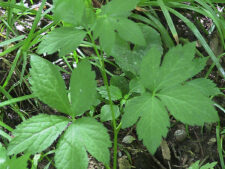
This native biennial grows up to 3 feet tall. Alternate toothed leaves divided into 3 leaflets surround an erect stem (B). The outer 2 leaflets of the lower leaves are often deeply lobed, looking more like 5 rather than 3 leaflets (C). A few tiny greenish-white flowers are found on the developing burs which form clusters at the ends of its branches (D). The oval burs are arranged in longitudinal rows; they have bristles with hooks.
Found in upland and lowland woods, flowering in June and July. Common in upland and lowland woods at Neale Woods where it is significantly more common than its look alike Clustered Black Snakeroot (S. odorata). Both species are common in Fontenelle Forest.
The Black Snakeroots (Sanicula) are easily recognized by their clusters of bur-like seed heads with curved bristles and compound leaves divided into 3 or 5 palmate leaflets. Separation of our 2 closely related species is fairly easy when flowering; Canadian (S. canadensis) has tiny greenish-white flowers while those of Clustered Black Snakeroot (S. odorata) are greenish-yellow and more numerous. Good luck separating them when not flowering!
The content of NatureSearch is provided by dedicated volunteer Naturalists of Fontenelle Forest who strive to provide the most accurate information available. Contributors of the images retain their copyrights. The point of contact for this page is: Roland Barth.

 Identification
Identification

